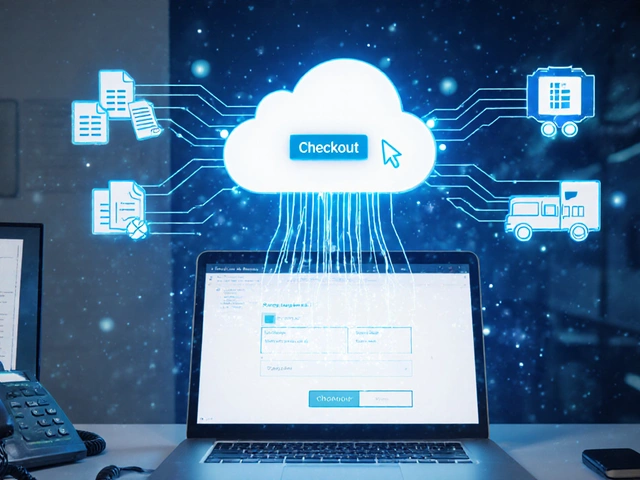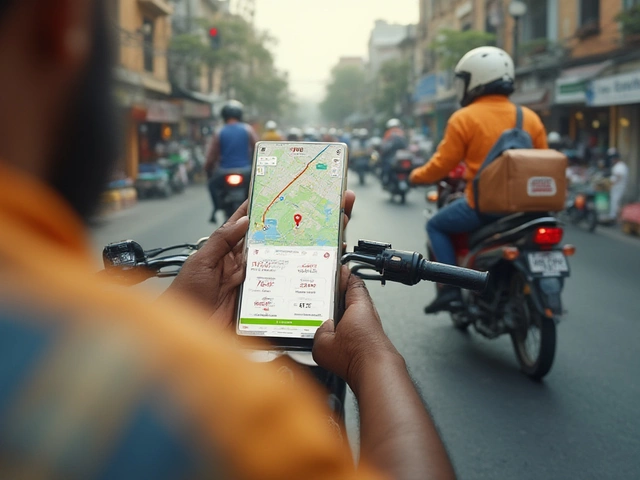If you've ever thought about joining Amazon Flex as a driver, you're probably curious about the whole deal with fuel costs. Does Amazon chip in for gas, or is it all on you? The truth is, Amazon Flex operates a little differently from traditional delivery jobs. As a driver, you're considered an independent contractor, which means fuel costs come out of your pocket. But don't worry, there are smarter strategies to make sure it's still a profitable gig.
Amazon Flex doesn't cut a check for gas, but knowing how to manage this expense can make a massive difference in your take-home pay. Many drivers learn to plan their routes effectively, timing their drives when traffic is light to save on gas. There's also the option to claim mileage deductions when tax season rolls around, which can help offset some of those fuel costs. It's not just about driving; it's about thinking smart to pocket more earnings.
- The Basics of Amazon Flex
- Fuel Costs: Who Foots the Bill?
- Maximizing Earnings as a Driver
- Managing Fuel Expenses
- Real-Life Experiences from Drivers
- Weighing the Pros and Cons
The Basics of Amazon Flex
Amazon Flex is like the Uber for delivering packages. Instead of passengers, you're delivering parcels. It’s a gig economy job that allows folks to earn some extra cash by delivering Amazon packages using their own vehicles. So, how does it work? Pretty straightforward. You use the Amazon Flex app, which is sort of like your command center. It tells you everything—from where to pick up packages to the best routes for delivery.
An essential thing to know is that as a Flex driver, you're an independent contractor. This means that the gig gives flexibility—choose your delivery blocks, work as much or as little as you want—but it also means handling costs like gas yourself. That's key to keep in mind if you're calculating what you'll earn.
The Verge once reported, "For someone looking to make quick money with flexibility, Amazon Flex has become a viable option."
It's not just about flexibility. Amazon Flex can be quite competitive. Sometimes, those 3- or 4-hour delivery blocks can snag you anywhere between $18 to $25 an hour. But remember, that's gross pay, and you’ll need to subtract expenses like mileage and fuel.
Amazon offers a neat feature called Instant Offers. These are, as the name suggests, immediate delivery opportunities, often from Amazon Fresh or Whole Foods. If you're near a store, you might get a ping to pick and drop off right there. They can be a nice way to fill gaps or bulk up your earnings between scheduled delivery blocks.
Amazon Flex is appealing largely because of its flexibility, but also because it doesn’t tie you down with long commitments. It’s essential to weigh this element alongside costs when deciding if it’s the right gig for you.
Fuel Costs: Who Foots the Bill?
When diving into the world of Amazon Flex, one of the first questions drivers ask is about fuel costs. So, who pays? Well, Amazon Flex drivers are classified as independent contractors. This means fuel costs, along with vehicle maintenance and other related expenses, are your responsibility. It's not like a traditional job where a company vehicle with a fuel card gets handed over.
With that in mind, it's crucial to budget for these expenses as they can significantly impact your earnings. Some seasoned drivers suggest keeping track of mileage and fuel consumption to better understand costs. Since you're playing the dual role of driver and business owner, efficient planning can help in not burning too much cash on gas.
There are financial perks many might overlook, such as the ability to claim a tax deduction for mileage, which is potentially more beneficial than keeping receipts for every gas purchase you make. It's usually a good idea to brush up on what you're eligible for come tax time, to offset these fuel costs.
Fuel isn't just an expense—it's a strategy game. Drive smart to earn well!
Maximizing Earnings as a Driver
Driving for Amazon Flex can be a decent gig, but to really make it worth your time, it's key to focus on optimization. Let's delve into how you can squeeze the most out of every delivery block.
First up, take advantage of the surge pay zones. Sometimes Amazon offers higher pay rates in certain areas to cover the increased demand or tougher delivery conditions. Keep an eye on your app notifications to grab these opportunities. They can really bump up your earnings.
It's not just about driving more but driving smart. Plan your route to reduce mileage, which is the main factor in fuel costs. With apps like Waze or Google Maps, you'll often find faster routes while avoiding nasty traffic jams.
Stacking multiple deliveries in a single trip can also make a difference. This means you'll get paid for several pickups and drop-offs without spending extra time or gas. An efficient route planner can help arrange your deliveries in the best sequence, saving both time and money.
Now let's talk taxes. As an independent contractor, you're responsible for filing your income taxes. Make sure to keep track of your expenses like mileage, parking fees, and vehicle maintenance. When tax season comes around, these deductions can help lower your taxable income significantly.
- Use a mileage tracking app to log your miles for deductions.
- Take care of your vehicle—this includes timely oil changes and tire checks to keep running costs low.
- Schedule your shifts strategically, focusing on peak hours or high demand days like weekends and holidays.
As you find your rhythm with Amazon Flex, you'll get a better sense of what works and what doesn't. Balancing time, expenses, and earnings is the key. Though Amazon Flex doesn't cover your fuel costs, these strategies can help you maximize your take-home pay.

Managing Fuel Expenses
Driving for Amazon Flex can present unique challenges, especially since the fuel costs are all yours to handle. But there are smart ways to keep those costs as low as possible while maximizing your profits.
First off, planning your driving schedule can make a huge difference. Try to pick delivery slots during off-peak hours when traffic is lighter. Less idling means less fuel burned. Keep an eye on your vehicle maintenance too—simple things like keeping your tires properly inflated can improve gas mileage in a big way.
Another pro tip is to make use of apps that track gas prices. Apps like GasBuddy can help you find the cheapest gas stations along your route, saving you a little extra every time you fill up. While you're at it, consider joining fuel rewards programs offered by various gas stations. They accumulate discounts over time and can add up to a nice saving on your monthly gas bill.
Then, there's the magic of tax deductions. As an independent contractor, you can deduct your mileage at tax time. For 2025, the IRS standard mileage rate is 57.5 cents per mile. Keeping a detailed log of your mileage using tools like MileIQ can save you serious cash come April.
For the tech-savvy, smart route optimization apps like Waze or Google Maps can help you find the best paths to avoid extra mileage. Choosing the shortest and quickest routes isn't just good for gas savings, it shaves time off your deliveries too.
Efficiency, as they say, is key. So, while Amazon Flex doesn't cover your fuel costs, taking control with these strategies can turn a potential downside into a win. Drive wisely, spend smartly, and keep more of that hard-earned cash in your pocket!
Real-Life Experiences from Drivers
Getting the inside scoop from those who’ve driven for Amazon Flex is super helpful if you’re thinking about hopping on the delivery bandwagon. Many drivers have shared their stories online and in forums, offering a peek into what it’s really like handling your own fuel costs.
Let’s talk numbers. Some drivers break down their expenses, revealing that on a typical delivery day, they might spend about $20 on gas. It all depends on where you're delivering. If you're in a city with lots of stops close together, you could end up using less fuel, whereas rural areas might require more driving and more gas.
One driver, for instance, noted he covers about 70-100 miles per shift, which can add up fast. However, by choosing the right times to drive—like avoiding rush hours—he claims to save on both fuel and time. Smart, huh?
Here’s the thing: to really stretch your earnings, some drivers suggest tracking your mileage. When tax time comes around, you might be able to deduct some of those miles, easing the overall expense load.
A few savvy drivers also keep an eye on gas prices, filling up at stations with loyalty programs or discounts to save a few bucks. It's amazing how those little savings add up!
It's important to know that Amazon Flex drivers often highlight the need for flexibility. Some zones are more profitable than others, and knowing which areas offer the best returns can really help. Networking with other drivers can provide tips on the best routes and times to maximize your earnings, even when you’re paying out of pocket for fuel.
Weighing the Pros and Cons
Driving for Amazon Flex has a mix of perks and challenges, just like any gig job. On the plus side, the flexibility is a massive win. You get to set your schedule, which is perfect if you're juggling other commitments or simply enjoy not having a boss hovering over you. This kind of freedom is something a lot of folks cherish in today’s gig economy.
On the downside, the fuel costs are a biggie. Since drivers handle their own fuel expenses, paychecks can take a hit when gas prices spike. One driver shared, "It can be a little jarring when gas costs eat into your earnings, but if you plan your routes smartly, it balances out." You do have to be strategic about when and where you drive to get the best bang for your buck.
Another con is that there's no traditional job security or benefits like health insurance that you'd normally have in a typical job. You're your own boss, which sounds great until you realize there's no safety net.
"Driving for Amazon Flex offers tremendous freedom, but with that freedom comes responsibility and unpredictability," says a veteran Flex driver.
At the end of the day, working as an Amazon Flex driver is a good option if you're looking for flexible, short-term work. It's not without its challenges, especially when it comes to fuel costs and lack of benefits, but for many, the pros decidedly outweigh the cons, provided you approach it with the right mindset and strategies.





